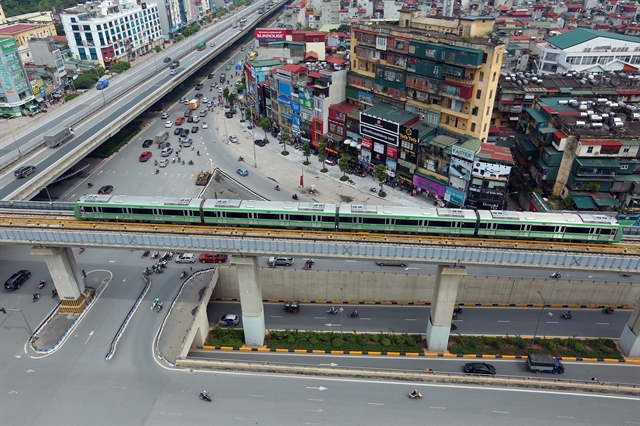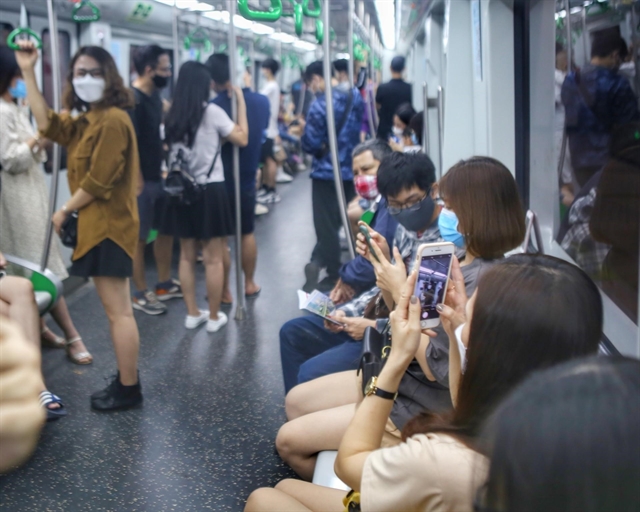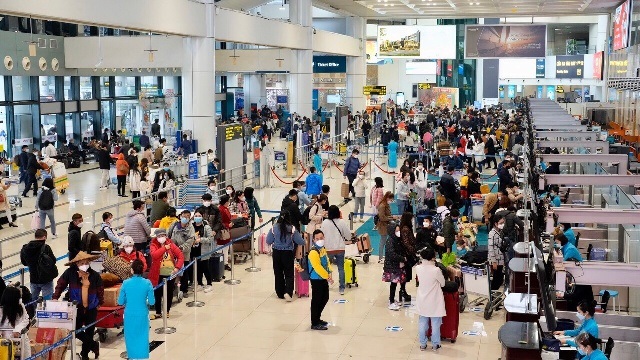.jpg) Society
Society

Many Hanoians say they prefer to use Cát Linh – Hà Đông elevated train, which officially opened last Saturday, instead of using personal vehicles.

|
| Cát Linh – Hà Đông elevated train - viewed from above.— VNA/VNS Photo Huy Hùng |
HÀ NỘI — Many Hanoians say they prefer to use Cát Linh – Hà Đông elevated train, which opened last Saturday, over their personal vehicles.
Nguyễn Thanh Vân, 38, of Đống Đa District, said that after using the train on Sunday she decided to take the train to go to the office from now on, instead of driving her motorbike.
“Travelling by train is very safe and convenient. No traffic jams, no dust, no noise pollution and no worries about rainy or sunny weather,” she said.
Nguyễn Thị Thu Hương, of Hà Đông District said: “It was a great experience. The train ran very smoothly, and the train staff were enthusiastic to guide passengers on how to board."
Hương said the route from her house to her office was suitable for travelling by train.
It only took about 24 minutes to travel from her home to the office by train, while it could take her an hour on her motorbike.
Other passengers had the same thoughts, and said that travelling by train was three to four times faster than by car or motorbike. Besides, the train space was clean and spacious.
It will only cost VNĐ200,000 (US$8.8) for a monthly ticket to travel by train, cheaper than the cost of running a personal vehicle each month.
However, several passengers were hesitant to choose the train because there was no parking space for their personal vehicles at stations.
Lê Văn Được, of Hà Đông District, said he went by the train on Saturday and it ran smoothly and quickly. However, he had to go on foot to Phùng Khoang Station because there was no parking space there.
“It takes me 20 minutes to go on foot,” he said.
It is possible to go on foot in the winter, but it will be inconvenient in the summer or on rainy days, he added.

|
| Passengers on the Cát Linh - Hà Đông elevated trains.— VNA/VNS Photo Tuấn Đức |
Parking solutions
Vũ Hồng Trường, director general of Hà Nội Metro One Member Limited Company (Hà Nội Metro), said the police together with units such as traffic inspectors and Hà Nội’s Transport Department were tasked with arranging the parking activities of passengers during the first 15 days of free travel.
Currently, Hà Nội Metro temporarily provides the lobby B of Cát Linh Station for passengers to park personal vehicles during the first seven days when the department is arranging locations for parking lots, he said.
The city has also ordered the transport department to survey and arrange parking lots to serve train passengers within a radius of 300-400m from the stations, he said.
In the handbook for passengers, Hà Nội Metro also suggests available parking lots near the stations.
Hà Nội Traffic Management and Operation Centre's Director Nguyễn Hoàng Hải said when the project of building Cát Linh – Hà Đông Railway Station started, there was no space left to arrange for parking at stations. Therefore, the transport department was now conducting a survey to set up parking lots near 10 of the 12 stations.
Hải also said the two stations of Cát Linh and Yên Nghĩa, located at the start and end of the line, would set up parking lots as they had enough space.
Cát Linh – Hà Đông elevated railway, with a total investment of approximately US$868 million (US$315 million higher than initial estimates) and funded by China’s official development aid, officially carried its first passengers last Saturday after 10 years of construction.
The line is more than 13km long and has 12 stations and 13 trains. Each train, with speeds up to 80km per hour, has four carriages, capable of carrying more than 900 passengers in total.
The initial commercial routes of the railway were divided into two phases. The first, lasting six months, includes the first 15 days of free travel for all passengers, with four to six trains running from 5:30am to 10pm, at 10 to 15 minute intervals.
In the second phase, also for six months, there will be a total of nine trains running from 5:30am to 10:30pm, with 10-minute intervals, reduced to six minutes during peak times.
To board, people have to go to the second floor of the stations, obtain a ticket from the automatic ticket machines, or buy directly from ticket kiosks, and then enter the ticket barriers. — VNS


.jpg)





.jpg)
